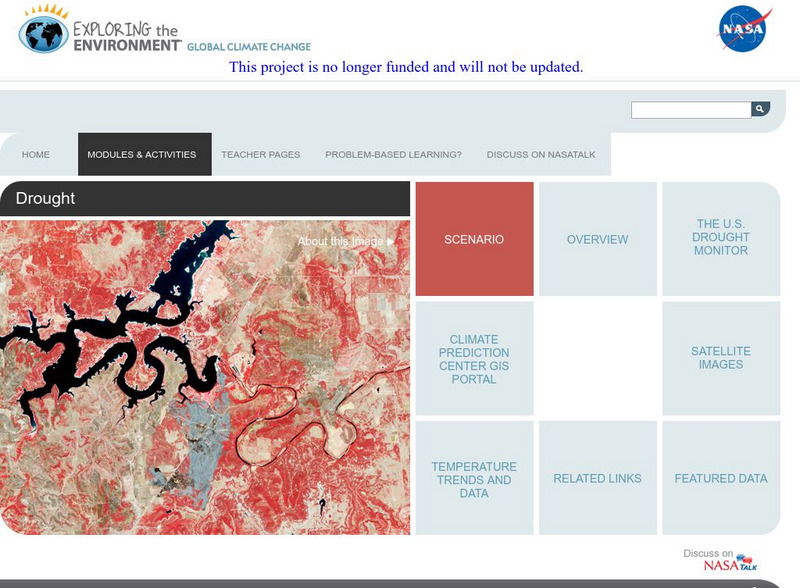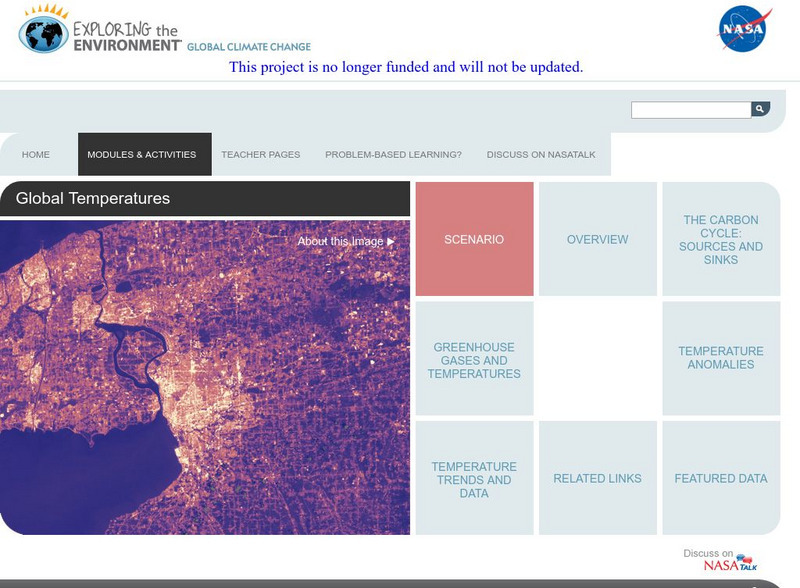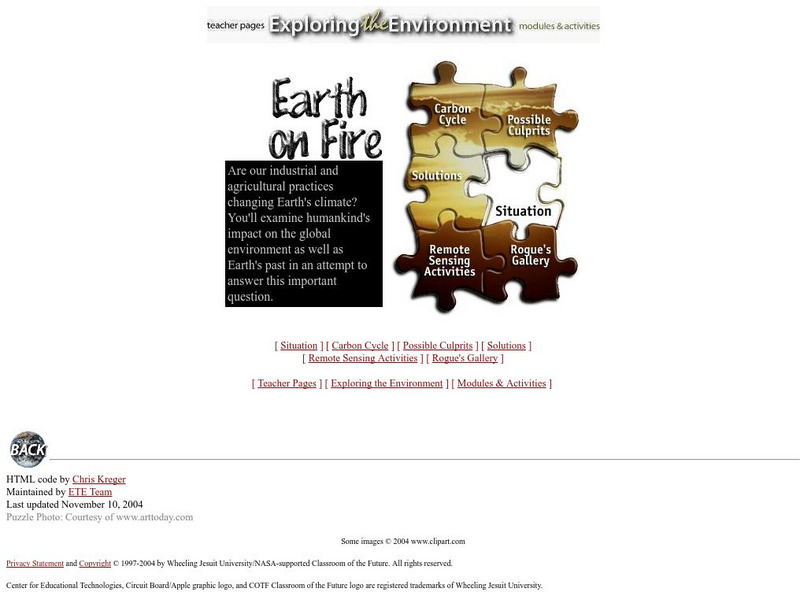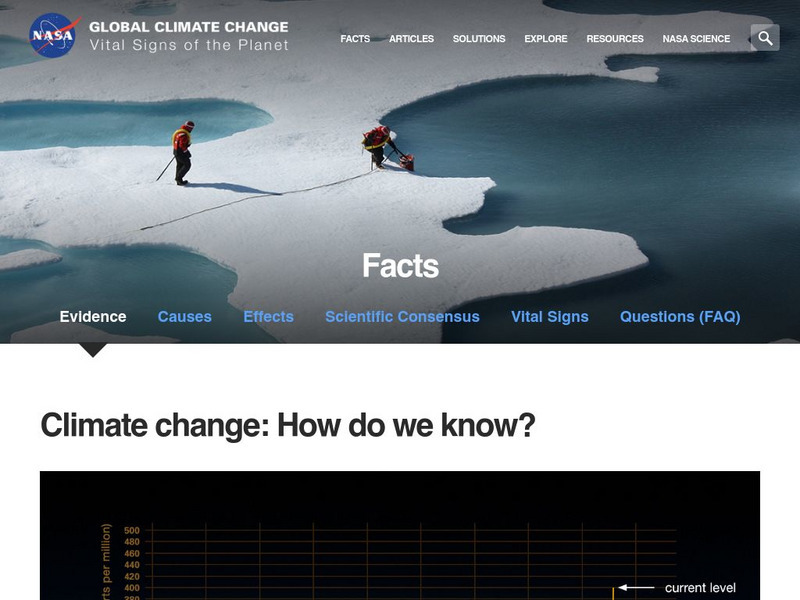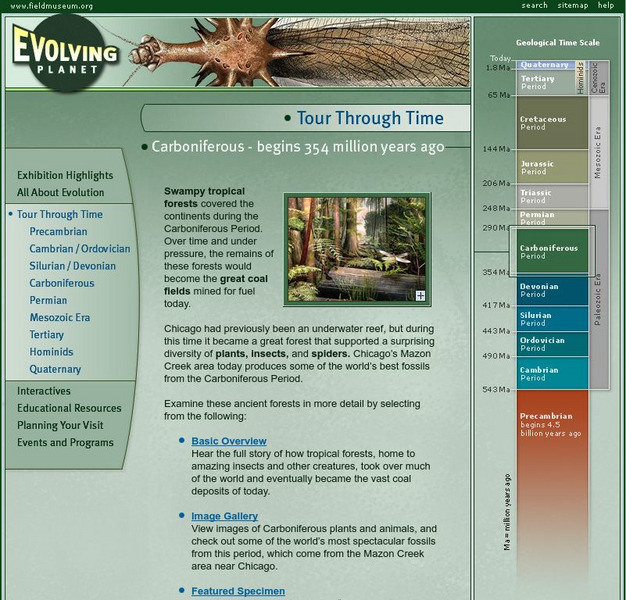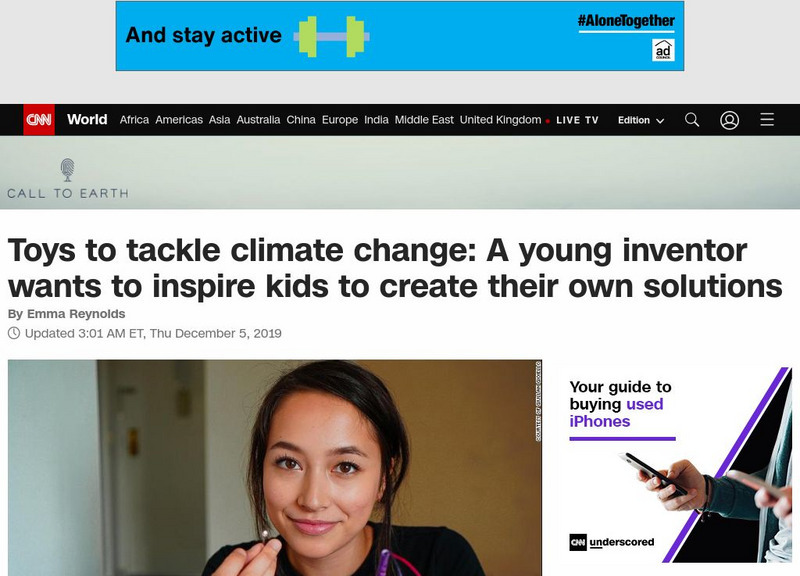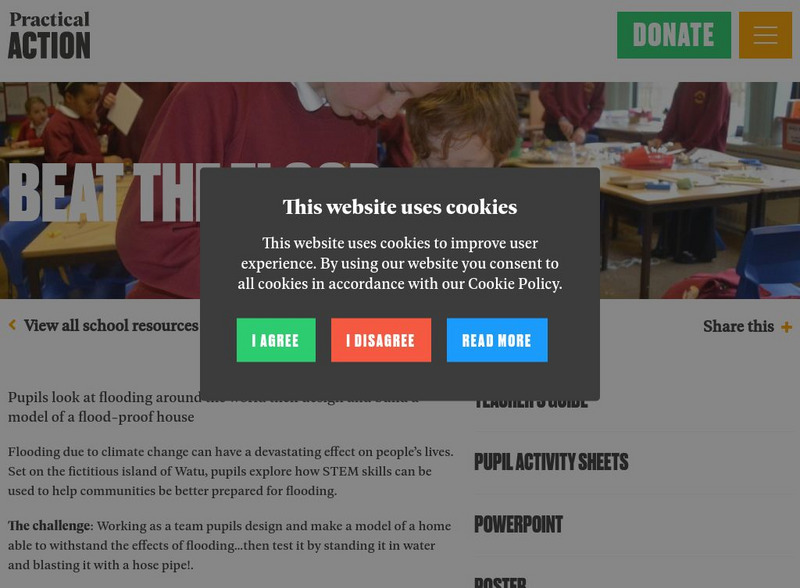Center for Educational Technologies
Cet: Exploring the Environment: Drought
The U.S. National Park Service has asked students to advise it whether the drought that greatly impacted the Midwest and Southwest is a consequence of global climate change or just an abnormal weather pattern. In either case, they will...
Center for Educational Technologies
Cet: Exploring the Environment: Global Temperatures
As a climate scientist, provide analysis and projected consequences of temperature data to present to a U.S. panel convening to study the impact of global climate change.
Center for Educational Technologies
Cet: Exploring the Environment: Human Health Effects
As an epidemiologist on the U.S. Panel for Climate Change, students are tasked with analyzing the latest data on climate-impacted human health conditions. A solid understanding of the mechanisms underlying the connections will allow for...
Center for Educational Technologies
Cet: Exploring the Environment: Ice Caps and Sea Levels
Students have just completed climate science fieldwork studying Earth's ice caps and sea levels. Analyze the data to present a report to the U.S. Panel on Global Climate Change.
Center for Educational Technologies
Nasa Classroom of the Future: Coral Reefs: Dissappearing Resource
Why are the reefs disappearing? Use this site to explore the science behind the issue. Useful at several grade levels.
Center for Educational Technologies
Nasa Classroom of the Future: Earth on Fire
Information and activities looking at the impact of industrial and agricultural practices on global warming.
NASA
Nasa: Climate Change: How Do We Know?
Provides extensive evidence of the many ways scientists have observed and recorded climate change on a rapid, global scale. Lists different events observed, such as receding ice sheets and evidence in rocks, and presents graphs, images,...
PBS
Pbs Learning Media: Greenland Ice Sheet Project 2: A Record of Climate Change
Using images and graphs, this interactive resource illustrates scientists' efforts to study Earth's climatic history for the last 250,000 years by drilling into the Greenland Ice Sheet and examining ice cores. Includes background reading...
PBS
Pbs Learning Media: Climate Change
This video segment adapted from NOVA explains the difference between weather and climate and features groundbreaking analysis revealing that Earth's climate has changed much faster than previously believed. [5:48]
Nature Research
Nature Education: Energy Economics in Ecosystems
This article discusses how plants and microorganisms, until recently, have mostly controlled how much carbon dioxide is released into an ecosystem, and explains how this process works. Humans' burning of fossil fuels has upset the...
NASA
Nasa: Exploring Climate Change
Test your knowledge of energy and its role in Earth's climate system with these interactive quizzes.
American Museum of Natural History
American Museum of Natural History: Ology: Rising Co2! What Can We Do?
With this resource, students learn how much fossil fuel emissions have increased since 1600 by exploring a graph showing carbon dioxide in our atmosphere. Then answer questions and read facts about climate change over the centuries....
Other
Future Agricultures Consortium
An Africa-based alliance of research organizations seeking to provide timely, high-quality and independent information and advice to improve agricultural policy and practice in Africa.
The Field Museum
Field Museum: Exhibits: Evolving Planet: Carboniferous
Explore this impressive compilation of scientific research focused on the Carboniferous Period in the late Paleozoic Era.
Story Behind the Science
Story Behind the Science: Realization of Global Warming [Pdf]
Article describing the history of how scientists developed their current understanding of global warming. It discusses why it is difficult for some people to accept that human beings have caused the Earth to warm, without controlled...
NASA
Nasa: Why Is Carbon Important?
Students explore the relationship between atmospheric carbon dioxide concentrations and temperature, and how these relate to climate change. Graph and map data are used as evidence to support the scientific claims they develop through...
King's Centre for Visualization in Science
Explaining Climate Change: What Now? Responding to Climate Change
This is the ninth lesson in a series of learning modules on the topic of climate change. It examines what humans can do to lessen the impact of climate change. Students will look at global data for carbon dioxide emissions now and...
NASA
Nasa: Climate Kids
Climate Kids thoroughly covers climate change and global warming. There are videos, games, puzzles (e.g., Cloud Picture Scrambles), interactives (e.g., the Climate Time Machine) and stories (e.g., Climate Tales). An educators' page links...
University Corporation for Atmospheric Research
Ucar: Hurricanes and Climate
Learners investigate maps and data to learn where and when hurricanes form and how climate change may be affecting them.
CNN
Cnn: Toys to Tackle Climate Change: A Young Inventor Wants to Inspire Kids
This article profiles a young woman named Ann Makosinski who has been hailed as a 'child prodigy' for her toy inventions that use renewable energy. She earlier invented, for example, a flashlight that is powered by heat from the hand and...
University Corporation for Atmospheric Research
Ucar: Little Ice Age: Working With Indirect Evidence of Past Climates
Students explore the differences between direct and indirect evidence to understand how climate has varied through time.
University Corporation for Atmospheric Research
Ucar: Little Ice Age: Blooming Thermometers
In this lesson, young scholars develop an understanding of the relationship between natural phenomena, weather, and climate change, the study known as "phenology." In addition, they learn how cultural events are tied to the timing of...
Practical Action
Practical Action: Beat the Flood
Flooding due to climate change can have a devastating effect on people's lives. Set on the fictitious island of Watu, pupils explore how STEM skills can be used to help communities be better prepared for flooding. Students will work as a...


